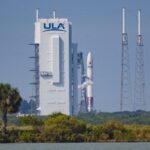A quartet of satellites launched tonight, the Magnetospheric Multiscale observatories. The four identical satellites will observe and measure magnetic reconnection, the explosive moment when mismatched magnetic fields connect, realign, and reconnect in a new configuration.
Top image: Artist’s concept of the Earth’s protective magnetosphere with the tetrahedral constellation of MMS observatories. Credit: NASA/Goddard/Conceptual Image Lab
An Atlas V rocket launching out of Cape Canaveral carried the Magnetospheric Multiscale observatories into orbit on March 12, 2014. Image credit: NASA/Aubrey Gemignani
The four identical
Magnetospheric Multiscale (MMS) observatories launched were boosted into orbit by a United Launch Alliance Atlas V rocket at 10:44 p.m. EDT on Thursday, March 12, 2015. Once in space, the spacecraft detached from the upper stage rocket every five minutes. NASA engineers were able to confirm that all four satellites were in good health by 12:40 am on Friday morning.
An Atlas V rocket blasting off from Space Launch Complex-41 at 10:44 pm EDT on Thursday. Image credit: ULA
The launch went off on-time and uneventfully, aside from the glorious roar of a rocket shedding the shackles of gravity. You can watch the launch replay here:
The launch vehicle was a United Launch Alliance Atlas V rocket in an Atlas 421 configuration. The main RD-180 engine system is a single engine with a pair of thrust chambers is capable of delivering 860,200 pounds of thrust at sea level. It is assisted at launch with a pair of solid rocket boosters providing an additional 348,500 pounds of thrust to get the spacecraft and rockets headed into orbit. In less than five minutes after launch, the lower stages were shed leaving a Centaur second stage to carry the payload into orbit with its single a single RL10A engine generating 22,300 pounds of thrust. After a long coasting period where the spacecraft slowly rolled to avoid temperature problem from unevenly baking in the sun, the spacecraft began releasing its payload one observatory at a time just over 1.5 hours after launch. After the final satellite was released, the Centaur barrelled away to dump its fuel to reduce the risk of a messy explosion during destructive reentry.
Atlas V's RD-180 – with booster friends – makes for a pretty fiery tail. pic.twitter.com/R14RxEGJ4S
— Chris Bergin – NSF (@NASASpaceflight) March 13, 2015
The two-year MMS observatories mission is about better understanding magnetic reconnection, a fundamental process that occurs in our planetary magnetic field, the magnetic field of our home star, and in the far reaches of the universe.
Magnetic reconnection is when magnetic fields connect in a mismatched alignment, realign, and reconnect in a new configuration.
Stylized concept art of magnetic reconnection, when misaligned magnetic field lines come in contact and explosively realign. Image credit: NASA/Goddard/Duberstein
Reconnection is a dramatic moment, explosively releasing bursts of energy and accelerating particles to near lightspeed.
When they happen on the sun, magnetic reconnection events can spark solar flares and even coronal mass ejections. The plasma ejected from the sun can spark another magnetic reconnection event if they collide with the Earth’s magnetic field. If the magnetic field lines of incoming particles are pointed in vaguely the same direction as the Earth’s magnetic field, the collision is relatively gentle. If the fields are not aligned, the reconnection event is more dramatic. This is what happened when a coronal mass ejection hit the Earth on July 15th and 16th, 2012 with magnetic field lines almost completely perpendicular to the local planetary field. This disruption sparked a geomagnetic storm, pushing in the magnetic field and exposing normally-protected satellites, triggering more magnetic reconnection events, and spawning countless gorgeous aurora.
The Earth’s magnetic field under bombardment on July 15 to 16, 2012 with several magnetic reconnection events. Gif extracted from video by NASA/CCMC/Bridgman
Previous satellites have been strictly observational, recording that events happened but that’s about it. The identical quartet will not only observe and measure the events as they happen, but by orbiting in an unusual tetrahedral formation, they will be able to provide a three-dimensional view of magnetic reconnection for the first time. Building the satellites was a challenge not just for the new technologies involved, but also for the complexity of simultaneously constructing four identical spacecraft when in the habit of building one or two spacecraft at a time.
MMS #2 being lowered into the Passive Ring of the flight Separation System. Image credit: NASA/Goddard
The key experiment is the Fast Plasma Investigation (FPI), which is composed of eight detectors per spacecraft with two sensors per detector. Half the detectors are dedicated to measuring ions, while the other half detect electrons.
Each observatory is loaded with sensors to create full-sky maps of ion plasma and electrons. Image credit: NASA/Goddard
Each sensor scans in a 45° arc: between them all, the ion sensors can produce a full-sky three-dimensional picture of ion plasma every 150 milliseconds, while the electron sensors map electrons every 30 milliseconds. This is approximately 100 times faster than measurements made by earlier instruments, providing more detailed resolution for observations of how magnetic reconnection events unfold over time. All of this data is fed into one processing unit per spacecraft.
All four MMS observatories the White House Cleanroom of Goddard Space Flight Center. Image credit: NASA/Goddard
Magnetic reconnection happens everywhere that we find magnetic fields, so we’re taking the path of convenience by stationing the satellites to observe magnetic reconnection within the Earth’s magnetic field.
The quartet will start in the nose of the magnetosphere, then switch after a year to loiter in the magnetotail.
Planned orbit for the tetrahedral constellation of four MMS observatories. Grey regions mark known areas of magnetic reconnection events. Image credit: NASA
What we learn here will help us understand what’s happening in the magnetic fields of other planets, the sun and other stars, at the edge of the heliosphere separating our solar system from interstellar space, and even in exotic locations like black holes and neutron stars.
All four MMS observatories stacked and ready to be encased in a protective payload fairing prior to launch. Image credit: NASA/Ben Smegelsky
Writing for NASA, Karen C. Fox explains the significance of this mission:
This kind of improved observation capability is like exploring a new continent previously seen only by satellite pictures. The depth and detail of our knowledge is going to grow by leaps and bounds, in ways that no one can yet predict. The scope is expected to be vast, with applications to the science of black holes, neutron stars, the sun, and, of course, space weather effects near Earth.
Learn more about the mission in this overview video produced by NASA:
Read more about the Magnetosphere Multiscale observatories and the launch in this press kit. Think you’ve got a handle on the mission? Test your knowledge with this quiz!











